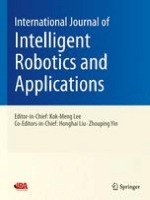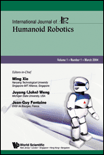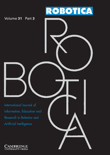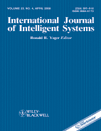
JOURNAL OF INTELLIGENT & ROBOTIC SYSTEMS
Scope & Guideline
Shaping Tomorrow's Intelligent Systems Today
Introduction
Aims and Scopes
- Autonomous Robotics:
Research on robots capable of performing tasks without human intervention, including navigation, manipulation, and interaction with dynamic environments. - Intelligent Control Systems:
Development of advanced control strategies for robotic systems, incorporating algorithms such as model predictive control, reinforcement learning, and fuzzy logic. - Human-Robot Interaction:
Exploration of frameworks and technologies that enhance collaboration between humans and robots, focusing on safety, usability, and adaptability. - Multi-Agent Systems:
Studies on the coordination and cooperation among multiple robotic agents to achieve complex tasks, including swarm robotics and decentralized control. - Robotic Perception and SLAM (Simultaneous Localization and Mapping):
Research on sensory systems and algorithms that allow robots to perceive their surroundings and navigate effectively in unknown environments. - Applications in Various Fields:
Investigations into the application of robotic systems in sectors such as healthcare, agriculture, transportation, and industrial automation.
Trending and Emerging
- Deep Learning and AI Integration:
An increasing number of papers are focusing on the integration of deep learning techniques with robotic systems, enabling enhanced perception, decision-making, and adaptability in complex environments. - Robotics for Healthcare and Rehabilitation:
There is a notable rise in research dedicated to the development of robotic systems for healthcare applications, including rehabilitation robots and assistive technologies for patients with disabilities. - Autonomous Systems in Unstructured Environments:
Research is trending towards the development of robotic systems capable of operating autonomously in unstructured and dynamic environments, such as disaster response scenarios and agricultural applications. - Collaborative Robotics and Human-Robot Teams:
The field is seeing a surge in interest in collaborative robotics, where robots work alongside humans in shared environments, focusing on safety, efficiency, and enhanced interaction. - Cybersecurity for Robotics and AI Systems:
With the rise of connected and autonomous systems, there is an emerging focus on cybersecurity measures to protect robotic systems from vulnerabilities and malicious attacks.
Declining or Waning
- Traditional Path Planning Algorithms:
There has been a noticeable decline in publications focused solely on conventional path planning algorithms, as researchers increasingly explore hybrid and adaptive methods that integrate learning and environmental feedback. - Basic Robot Manipulation Techniques:
Research on fundamental robotic manipulation techniques is becoming less prominent, with a shift towards more complex systems that utilize AI and machine learning for enhanced adaptability and efficiency. - Static Robot Models:
The focus on static or rigid robotic models is waning as there is a growing interest in soft robotics and bio-inspired designs that offer greater flexibility and adaptability in dynamic environments. - Legal and Ethical Considerations in Robotics:
While still relevant, the frequency of papers addressing the legal and ethical implications of robotics and AI has decreased as researchers prioritize technical advancements and practical applications. - Traditional UAV Applications:
The exploration of conventional applications for UAVs, such as basic surveillance and mapping, is declining as the field shifts towards innovative uses, including multi-agent coordination and advanced environmental monitoring.
Similar Journals

International Journal of Intelligent Robotics and Applications
Unlocking New Possibilities in Robotics and AIInternational Journal of Intelligent Robotics and Applications, published by SPRINGER SINGAPORE PTE LTD, is a pivotal platform dedicated to advancing the field of robotics and artificial intelligence. With an ISSN of 2366-5971 and an E-ISSN of 2366-598X, this journal has established its presence since its inception in 2017, showcasing innovative research and applications up until 2024. The journal aims to foster interdisciplinary collaboration by publishing high-quality articles that cover a broad range of topics from foundational AI concepts to cutting-edge robotics technologies. It holds respectable rankings, positioned in the Q3 category of Artificial Intelligence and Q2 category of Computer Science Applications in the 2023 metrics, and is indexed in Scopus with notable rankings in both computer science disciplines. Although it follows a subscription model, the journal remains committed to facilitating access to groundbreaking research for its audience of researchers, professionals, and students, contributing to the ever-evolving landscape of intelligent robotics.

AUTONOMOUS ROBOTS
Unleashing Potential in Autonomous Technology.AUTONOMOUS ROBOTS, published by SPRINGER, is a leading academic journal that serves as a pivotal platform for the dissemination of cutting-edge research in the field of Autonomous Robotics. With an ISSN of 0929-5593, this esteemed journal has been at the forefront of innovation since its inception in 1994, and it continues to thrive with a vision extending to 2024 and beyond. Recognized in the Q1 category of Artificial Intelligence, it boasts a commendable ranking of #85 out of 350 in Computer Science and Artificial Intelligence, positioning it within the 75th percentile of researchers' preferred publications. The journal features a range of subjects related to autonomous systems, including but not limited to robot perception, action planning, multi-agent systems, and autonomous interactions, catering to an audience that spans researchers, industry professionals, and students alike. Scholars can access a wealth of peer-reviewed articles that contribute to both theoretical frameworks and practical applications, ensuring the relevance of the work published within its pages. Located in Dordrecht, Netherlands, AUTONOMOUS ROBOTS exemplifies a commitment to advancing the science of robotics, making significant contributions to the knowledge base and inspiring new developments within the field.

International Journal of Humanoid Robotics
Driving Excellence in Robotics ResearchInternational Journal of Humanoid Robotics, published by World Scientific Publishing Co Pte Ltd, is a leading platform for researchers and practitioners in the fields of artificial intelligence and mechanical engineering. With an ISSN of 0219-8436 and an E-ISSN of 1793-6942, this journal has established itself as a significant resource since its inception in 2004. Spanning various topics from robotic design and control to human-robot interaction, it serves a diverse interdisciplinary audience. The journal’s impressive ranking in the Scopus database, positioned in the third quartile for both categories in 2023, reflects its growing impact in the academic community. Although not open access, the journal provides crucial insights that advance the understanding of humanoid robotics and foster innovative solutions to real-world challenges. Researchers, professionals, and students are encouraged to engage with this essential resource as it continues to shape the future of robotics through rigorous scientific inquiry and scholarly collaboration.

ROBOTICA
Innovating Insights in Robotics ResearchROBOTICA is a premier academic journal that serves as a vital resource within the multidisciplinary field of robotics and artificial intelligence. Published by Cambridge University Press, this journal boasts a comprehensive scope that encompasses areas such as computational mechanics, computer vision, control systems, and software applications. With an impressive range of quartile rankings in 2023, including Q2 in key categories like Computational Mechanics and Control and Optimization, ROBOTICA represents a significant contribution to its field, providing researchers and practitioners with cutting-edge insights and advancements. Although it follows a traditional subscription model, the journal maintains a commitment to accessibility through its esteemed indexing performance and robust academic standing, evidenced by Scopus rankings within the top percentiles across multiple relevant disciplines. Covering an expansive period from 1983 to 2024, ROBOTICA is essential for anyone looking to stay at the forefront of robotics research and innovation.

ADVANCED ROBOTICS
Exploring the Future of Intelligent MachinesADVANCED ROBOTICS is a premier journal published by Taylor & Francis Ltd that has been at the forefront of robotics research since its inception in 1986. With an esteemed ISSN of 0169-1864 and E-ISSN of 1568-5535, this journal offers a unique platform for disseminating high-quality research across diverse domains within the robotics field, encompassing applications in Computer Science, Control and Systems Engineering, Hardware and Architecture. Ranked in the Q2 quartile across multiple categories in 2023, ADVANCED ROBOTICS maintains a reputable standing in the academic community, emphasizing its commitment to advancing knowledge and innovation. Although not an Open Access publication, the journal’s access options ensure that subscribers can explore the latest findings and engage with prominent experts in the field, facilitating an enriching exchange of ideas. Researchers, professionals, and students alike will find ADVANCED ROBOTICS an invaluable resource for keeping abreast of developments and contributing to the ever-evolving landscape of robotics.

Journal of Field Robotics
Unleashing the Potential of Field Robotics ResearchJournal of Field Robotics, published by WILEY, is an esteemed peer-reviewed journal focusing on the cutting-edge developments in the area of robotics applied to real-world environments. With an ISSN of 1556-4959 and an E-ISSN of 1556-4967, this journal serves as a vital platform for researchers and professionals keen on advancing the fields of Computer Science Applications and Control and Systems Engineering, where it has earned a prestigious Q1 ranking in both categories as of 2023. The journal, which converges in its studies from 2006 to 2024, showcases original research that enhances the understanding and implementation of robotic systems in various fields, thus promoting innovative solutions to complex challenges. Access to the journal is through subscription-based options, ensuring a rigorous selection of high-quality research articles, reviews, and technical notes that contribute significantly to the academic community. With a solid Scopus ranking—39th out of 817 in Computer Science Applications and 17th out of 321 in Control and Systems Engineering, both in the 95th and 94th percentiles respectively—Journal of Field Robotics is essential reading for anyone interested in the future of robotics technologies and their transformative impact.

Artificial Life and Robotics
Exploring the Frontiers of AI and BiochemistryArtificial Life and Robotics, published by Springer, is a prominent journal in the fields of Artificial Intelligence and Biochemistry, Genetics, and Molecular Biology, with an ISSN of 1433-5298 and E-ISSN of 1614-7456. Established in 2005, the journal has continually contributed to knowledge and innovation in these rapidly evolving disciplines and is recognized for its significant impact, as indicated by its quartile rankings in the 2023 category assessments. The journal is currently positioned in Q4 for Artificial Intelligence and Q3 for General Biochemistry, Genetics and Molecular Biology, with a notable ranking of 138/221 and 262/350 in respective research areas. While it currently does not follow an open access model, it remains a valuable resource for researchers, professionals, and students seeking to advance their understanding and application of artificial life and robotic technologies. With an emphasis on interdisciplinary research, this journal aims to bridge theoretical foundations with practical applications, making it an essential platform for cutting-edge studies and discussions in the field.

INTERNATIONAL JOURNAL OF INTELLIGENT SYSTEMS
Exploring the Frontiers of Intelligent InnovationInternational Journal of Intelligent Systems, published by Wiley-Hindawi, stands at the forefront of the Artificial Intelligence, Human-Computer Interaction, Software, and Theoretical Computer Science fields. With an impressive Q1 ranking across multiple categories in 2023 and a robust track record since its inception in 1986, this journal is essential for researchers, professionals, and students alike who are eager to explore cutting-edge innovations and theoretical advancements. Located in the United Kingdom, the journal operates under the esteemed Wiley-Hindawi publishing house, ensuring a broad dissemination of high-quality research articles. The journal's diverse scope encompasses advancements in intelligent systems and their practical applications, fostering an interdisciplinary dialogue that encourages collaboration across various domains. Although Open Access options are not available, subscribers benefit from the rich repository of knowledge this journal offers, making it a vital resource in the rapidly evolving landscape of intelligent technologies.

Journal of Robotics Networking and Artificial Life
Unlocking Insights at the Intersection of Robotics and AI.Journal of Robotics Networking and Artificial Life, published by ALife Robotics Corp Ltd, stands at the forefront of interdisciplinary research at the intersection of robotics, artificial intelligence, and networking, representing a vital resource for scholars and practitioners in these rapidly evolving fields. Established as an Open Access journal since 2014, it provides unrestricted access to cutting-edge research and innovative methodologies, fostering collaboration and knowledge dissemination globally. Although it currently holds a Q4 ranking in both Artificial Intelligence and Computer Networks and Communications, its commitment to advancing knowledge through robust peer review and dedicated publication practices positions it as a growing contender within these spheres. With a publication history covering the years from 2019 to 2023, this journal emphasizes the importance of novel insights and cross-disciplinary approaches. Researchers, professionals, and students are encouraged to contribute to and engage with the evolving discourse in robotics and artificial intelligence, making the Journal of Robotics Networking and Artificial Life an essential addition to their academic and professional resources.

Advanced Intelligent Systems
Bridging Disciplines for a Smarter Tomorrow.Advanced Intelligent Systems, published by WILEY, stands as a prominent Open Access journal dedicated to the interdisciplinary exploration of intelligent systems, with a focus on materials science, engineering, and computer science. Since its establishment, the journal has fostered innovative research, providing a platform for the dissemination of findings that push the boundaries of artificial intelligence, human-computer interaction, and systems engineering. Although it is relatively new, having converged from 2023 to 2024, it ranks within various Scopus categories, showcasing its growing influence in fields such as mechanical engineering and computer vision. With an emphasis on accessibility, the journal has been Open Access since 2019, ensuring that cutting-edge research is available to a global audience of researchers, professionals, and students, thus driving forward the frontiers of intelligent systems development.